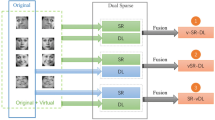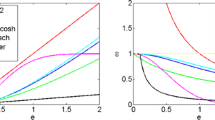Abstract
Sparse representation-based classification (SRC) has been a breakthrough of face recognition and signal reconstruction recently. However, few face images from the same subject provide insufficient observations. Meanwhile, owing to uncertainty of training images with variations in the appearance of facial illumination, pose and facial expression, it is difficult to successfully address the issues of image recognition and signal reconstruction. Thus, how to construct an optimized comprehensive dictionary is still a non-trivial task. In this paper, we develop a generalized virtual extended dictionary of SRC (V-SRC) to deal with data uncertainty problem, establishing a weighted mechanism which assigns different coefficients between arbitrary two within-class samples to obtain the virtual samples. More specifically, we firstly construct a set of synthesized training samples by means of weighted combination of existing training samples. Secondly, we combine the original and synthesized training samples as an initial extended dictionary. Thirdly, in order to decrease the constructed error in sparse representation, we exploit an elimination scheme to gain the robust training samples with respect to the initial extended training dictionary. The final goal of the proposed method is to utilize the linear combination of competitive training samples to perform face classification. Experimental results conducted on the AR, FERET and Georgia Tech databases demonstrate the effectiveness of the proposed method especially in the case of small sample size problem.









Similar content being viewed by others
Explore related subjects
Discover the latest articles, news and stories from top researchers in related subjects.References
Agarwal H, Renaud JE, Preston EL, Padmanabhan D (2004) Uncertainty quantification using evidence theory in multidisciplinary design optimization. Reliab Eng Syst Saf 85(1–3):281–294
AR database (1994). http://cobweb.ecn.purdue.edu/~aleix/aleix-face-DB.html
Bae HR, Grandhi RV, Canfield RA (2004) An approximation approach for uncertainty quantification using evidence theory. Reliab Eng Syst Saf 86(3):215–225
Ben-Haim Y, Elishakoff I (1990) Convex models of uncertainty in applied mechanics, vol 112. Elsevier, Amsterdam
Bhattacharyya C, Pannagadatta K, Smola A (2005) A second order cone programming formulation for classifying missing data. In: Proc. NIPS, pp. 153–160
Bi J, Zhang T (2004) Support vector classification with input data uncertainty. Adv Neural Inf Process Syst 17(5):161–168
Brodlie K, Osorio RA, Lopes A (2012) A Review of Uncertainty in Data Visualization. In: Expanding the frontiers of visual analytics and visualization, pp 81–109. Springer, London
Candes E, Tao T (2006) Near-optimal signal recovery from random projections: universal encoding strategies? IEEE Trans Inf Theory 52(12):5406–5425
Deng WH, Hu JN, Guo J (2012) Extended SRC: undersampled face recognition via intraclass variant dictionary. IEEE Trans Pattern Anal Mach Intell 34(9):1864–1870
Ditlevsen O, Madsen HO (1996) Structural reliability methods. Wiley, New York
Dubois D, Prade H, Harding EF (1988) Possibility theory: an approach to computerized processing of uncertainty, vol 2. Plenum Press, New York
Elhamifar E, Vidal R (2011) Robust classification using structured sparse representation. Proc IEEE Conf Comput Vision Pattern Recogn
FERET database (2007). http://www.itl.nist.gov/iad/humanid/feret/feret-master.html
Ferson S, Hajagos JG (2004) Arithmetic with uncertain numbers: rigorous and (often) best possible answers. Reliab Eng Syst Saf 85(1):135–152
Ghaoui LE, Lanckriet GRG, Natsoulis G (2003) Robust classification with interval data, Technical Report UCB/CSD-03-1279, Comput. Sci. Div., Univ. California, Berkeley
GTFB database (2010). http://www.computervisiononline.com/dataset/georgia-tech-face-database.html
Haldar A, Mahadevan S (2000) Probability, reliability, and statistical methods in engineering design. John Wiley & Sons Inc, New York
Lanckriet G, Ghaoui L, Bhattacharyya C, Jordan M (2002) A robust minimax approach to classification. J Mach Learn Res 3:555–582
Lee PM (2004) Bayesian statistics. Arnold, London
Leonard T, Hsu JSJ (2001) Bayesian methods: an analysis for statisticians and interdisciplinary researchers. Cambridge University Press, Cambridge
Liu YN, Wu F, Zhang ZH, Zhuang YT, Yan SC (2010) Sparse representation using nonnegative curds and whey. Proc IEEE Conf Comput Vision Pattern Recogn
Moller B, Beer M (2008) Engineering computation under uncertainty-capabilities of non-traditional models. Comput Struct 86(10):1024–1041
Rao SS, Annamdas KK (2009) Dempster-Shafer Theory in the analysis and design of uncertain engineering systems. In: Product research, pp 135–160
Sankararaman S, Mahadevan S (2013) Distribution type uncertainty due to sparse and imprecise data. Mech Syst Signal Process 37:182–198
Shafer G (1976) A mathematical theory of evidence, vol 1. Princeton University Press, Princeton
Shivaswamy P, Bhattacharyya C, Smola A (2006) Second order cone programming approaches for handling missing and uncertain data. J Mach Learn Res 7:1283–1314
Song XN, Zheng YJ, Wu XJ, Yang XB, Yang JY (2010) A complete fuzzy discriminant analysis approach for face recognition. Appl Soft Comput 10:208–214
Song XN, Yang JY, Wu XJ, Yang XB (2011) An optimal symmetrical null space criterion of fisher discriminant for feature extraction and recognition. Soft Comput 15:281–293
Song XN, Liu Z, Yang XB, Yang JY (2013) A fuzzy supervised learning method with dynamical parameter estimation for nonlinear discriminant analysis. Comput Math Appl 66:1782–1794
Wright J, Yang AY, Ganesh A, Sastry SS, Ma Y (2009) Robust face recognition via sparse representation. IEEE Trans Pattern Anal Mach Intell 31(2):210–227
Wright J, Ma Y, Mairal J, Sapiro G (2010) Sparse representation for computer vision and pattern recognition. Proc IEEE 98(6):1031–1044
Xu Y, Zhang D, Yang J, Yang JY (2011) A two-phase test sample sparse representation method for use with face recognition. IEEE Trans Circuits Syst Video Technol 21(9):1255–1262
Xu Y, Zuo WM, Fan ZZ (2012) Supervised sparse representation method with a heuristic strategy and face recognition experiments. Neurocomputing 79:125–131
Xu Y, Zhu XJ, Li ZM, Liu GH, Lu YW, Liu H (2013) Using the original and ‘symmetrical face’ training samples to perform representation based two-step face recognition. Pattern Recogn 46:1151–1158
Xu Y, Zhu Q, Fan ZZ, Zhang D, Mi JX, Lai ZH (2013) Using the idea of the sparse representation to perform coarse-to-fine face recognition. Inf Sci 238:138–148
Xu Y, Fang XZ, Li XL, Yang J, You J, Liu H, Teng SH (2014) Data uncertainty in face recognition. IEEE Trans Cybern 44(10):1950–1961
Xu Y, Jin Z (2008) Down-sampling face images and low-resolution face recognition. In: Proc. 3rd Int. Conf. Innovative Comput. Inform. Control, Jun., pp 392–395
Yang J, Zhang D, Frangi AF, Yang JY (2004) Two-dimensional PCA: a new approach to appearance-based face representation and recognition. IEEE Trans Pattern Anal Mach Intell 26(1):131–137
Yang J, Gunn S (2007) Exploiting uncertain data in support vector classification. KES 3:148–155
Yuan XT, Yan SC (2010) Visual classification with multitask joint sparse representation. Proc IEEE Conf Comput Vision Pattern Recogn
Zhang L, Yang M, Feng X, Ma Y, Zhang D (2012) Collaborative representation based classification for face recognition. Proc IEEE Conf Comput Vision Pattern Recogn
Acknowledgments
This work was supported in part by the Natural Science Foundation of China under Grants 61373055 and 61471182, in part by the Natural Science Foundation of Jiangsu Province under Grant BK20130473, and in part by the Fundamental Research Funds for the Central Universities under Grants JUSRP115A29 and JUSRP51410B.
Author information
Authors and Affiliations
Corresponding author
Ethics declarations
Conflict of interest
The authors declare that they have no conflict of interest.
Additional information
Communicated by V. Loia.
Rights and permissions
About this article
Cite this article
Song, X., Shao, C., Yang, X. et al. Sparse representation-based classification using generalized weighted extended dictionary. Soft Comput 21, 4335–4348 (2017). https://doi.org/10.1007/s00500-016-2064-7
Published:
Issue Date:
DOI: https://doi.org/10.1007/s00500-016-2064-7




